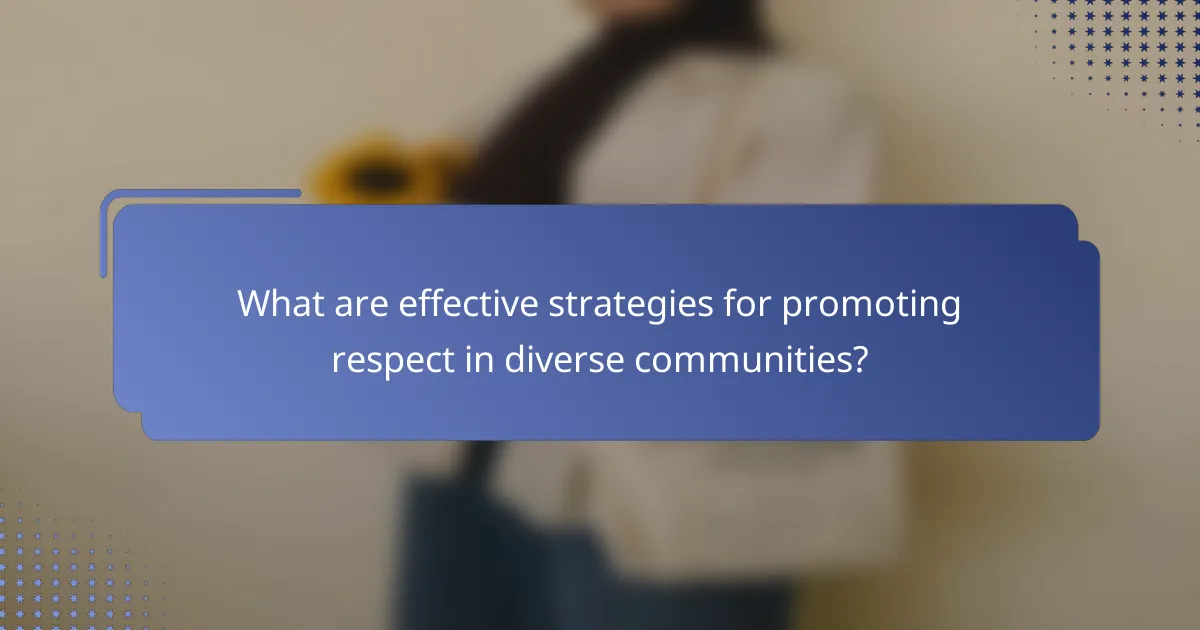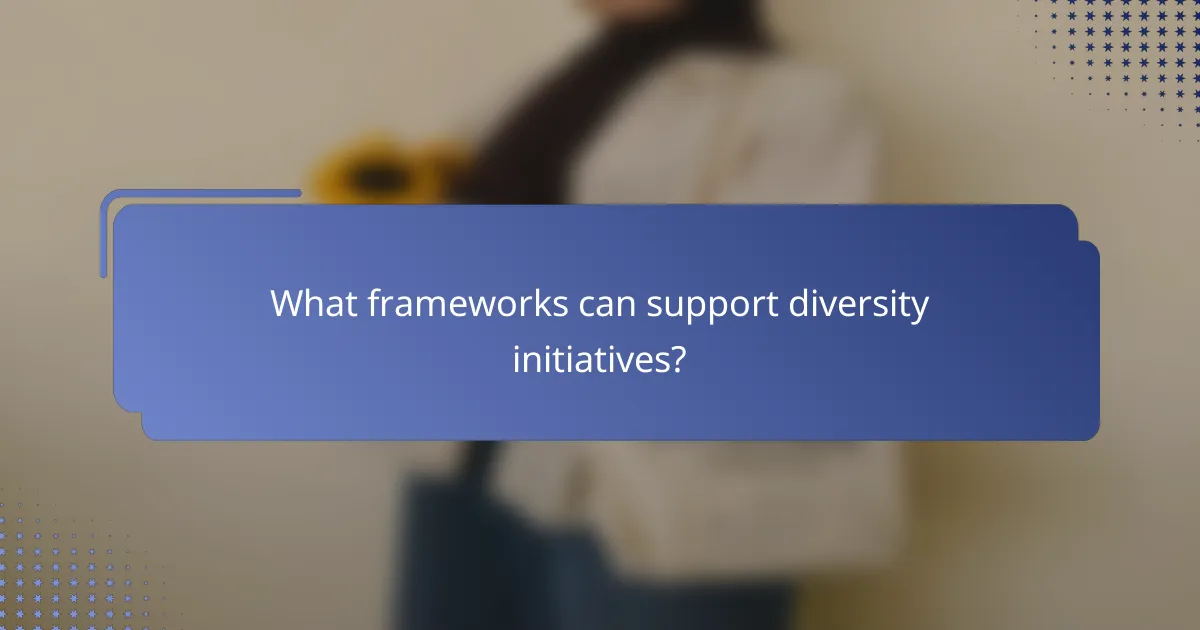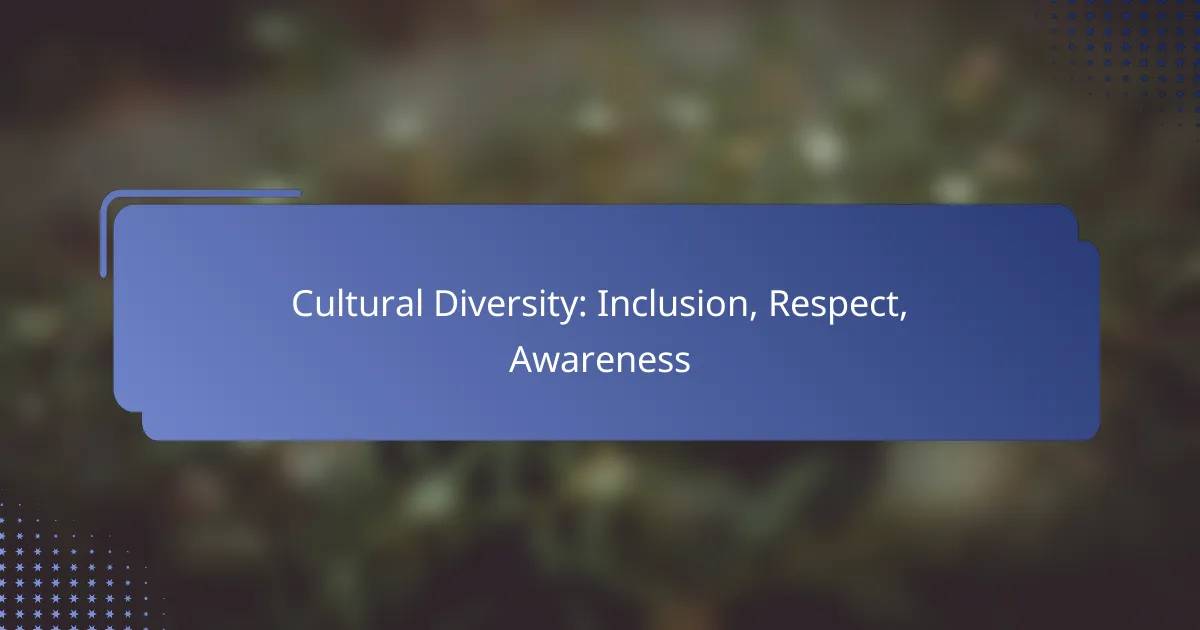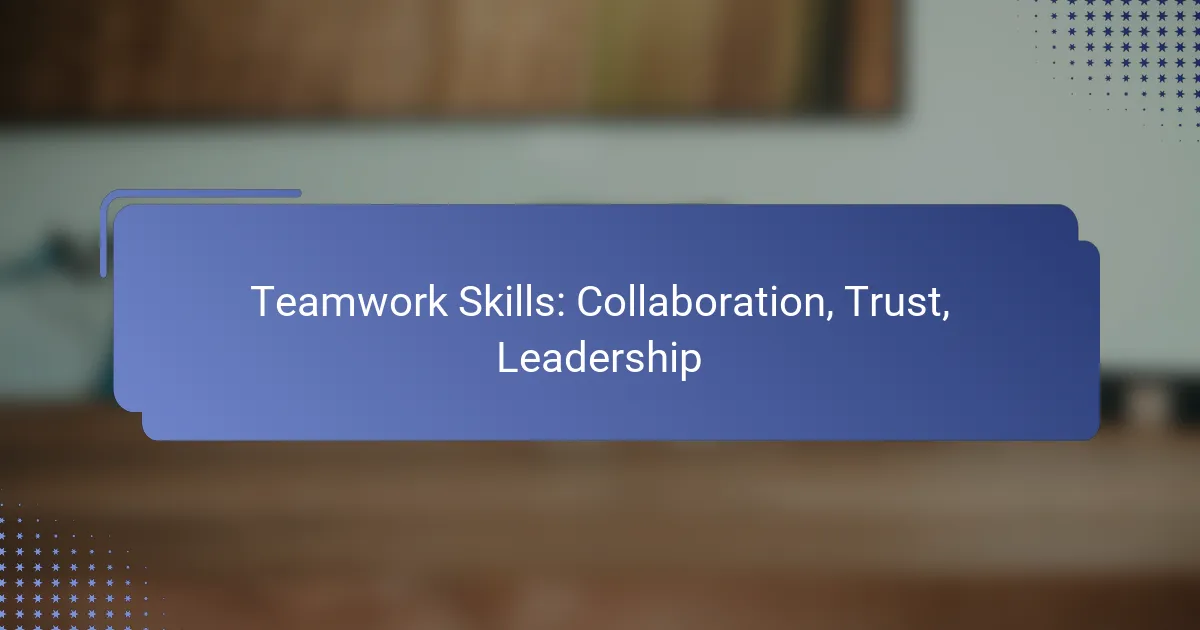Cultural diversity plays a crucial role in promoting inclusion, respect, and awareness within communities and organizations. By valuing varied perspectives, we can enhance collaboration and innovation, creating environments where everyone feels respected and understood. Embracing diverse backgrounds not only enriches our interactions but also fosters a deeper appreciation for the unique contributions each individual brings.

How can cultural diversity enhance workplace inclusion?
Cultural diversity enhances workplace inclusion by fostering an environment where varied perspectives are valued, leading to improved collaboration and innovation. Embracing different backgrounds allows organizations to create a more respectful and aware atmosphere, ultimately benefiting both employees and the company.
Improved team collaboration
When teams comprise individuals from diverse cultural backgrounds, collaboration improves significantly. Team members bring unique viewpoints and problem-solving approaches, which can lead to more effective communication and understanding. This diversity encourages open dialogue, helping to break down barriers and build stronger relationships among colleagues.
To maximize collaboration, organizations should promote inclusive practices such as team-building exercises that celebrate cultural differences. Regularly scheduled discussions can also help teams share their perspectives and experiences, fostering a collaborative spirit.
Increased creativity and innovation
Cultural diversity is a key driver of creativity and innovation in the workplace. Different cultural experiences inspire unique ideas and solutions, leading to a more dynamic and inventive work environment. Companies that embrace diversity often see a higher rate of innovation, as diverse teams can challenge conventional thinking and explore new possibilities.
To harness this creativity, organizations should encourage brainstorming sessions that welcome all ideas, regardless of their origin. Providing a safe space for employees to express themselves can lead to breakthroughs that benefit the entire organization.
Broader market reach
A diverse workforce enables companies to connect with a wider range of customers and clients. Employees from various cultural backgrounds can provide insights into different markets, helping businesses tailor their products and services to meet diverse needs. This understanding can lead to increased customer satisfaction and loyalty.
To effectively reach broader markets, companies should invest in training that highlights cultural competencies and market trends. Additionally, leveraging employees’ cultural insights can inform marketing strategies, ensuring that campaigns resonate with diverse audiences.

What are effective strategies for promoting respect in diverse communities?
Effective strategies for promoting respect in diverse communities include fostering open dialogue, implementing inclusive policies, and engaging in community programs. These approaches help build understanding and appreciation among individuals from different backgrounds.
Community engagement programs
Community engagement programs are essential for fostering respect in diverse settings. These initiatives can include cultural festivals, workshops, and discussion forums that bring together individuals from various backgrounds to share experiences and perspectives.
For example, organizing a multicultural fair can encourage participation and interaction among community members, allowing them to learn about each other’s traditions and values. Such events often lead to stronger relationships and a sense of belonging.
Inclusive policy development
Inclusive policy development ensures that the needs and voices of all community members are considered. This involves creating policies that promote equal opportunities and protect against discrimination based on race, ethnicity, gender, or other characteristics.
Communities can benefit from establishing advisory boards that include representatives from diverse groups. This approach helps ensure that policies reflect the community’s diversity and foster an environment of respect and inclusion.
Education and training initiatives
Education and training initiatives play a crucial role in promoting respect within diverse communities. These programs can provide individuals with the knowledge and skills needed to understand and appreciate cultural differences.
Workshops on cultural competency, anti-bias training, and conflict resolution can equip community members with tools to navigate diversity respectfully. Implementing these initiatives in schools and workplaces can create a more inclusive atmosphere and reduce misunderstandings.

How can awareness of cultural diversity be increased?
Increasing awareness of cultural diversity involves education, engagement, and active participation in diverse communities. By implementing targeted strategies, individuals and organizations can foster a deeper understanding and appreciation of different cultures.
Workshops and seminars
Workshops and seminars provide interactive platforms for participants to learn about various cultures. These sessions can cover topics such as cultural practices, communication styles, and historical contexts, enhancing participants’ understanding.
Organizations can host these events regularly, inviting speakers from diverse backgrounds to share their experiences. This approach not only educates but also encourages dialogue and personal connections among attendees.
Social media campaigns
Social media campaigns can effectively raise awareness of cultural diversity by reaching a wide audience. Creative content, such as videos, infographics, and stories, can highlight different cultural traditions and practices.
Engaging hashtags and challenges can encourage users to share their own cultural experiences, fostering a sense of community and inclusivity. Regularly updating content keeps the conversation alive and encourages ongoing participation.
Partnerships with cultural organizations
Forming partnerships with cultural organizations can enhance awareness initiatives by leveraging their expertise and resources. Collaborations can lead to joint events, educational programs, and community outreach efforts that promote cultural understanding.
These partnerships can also provide access to a broader audience, ensuring that diverse voices are represented. Organizations should seek to build long-term relationships with cultural groups to sustain awareness efforts and foster ongoing dialogue.

What role does leadership play in fostering cultural diversity?
Leadership plays a crucial role in fostering cultural diversity by establishing a framework that promotes inclusion, respect, and awareness within organizations. Effective leaders create an environment where diverse perspectives are valued and encouraged, ultimately enhancing collaboration and innovation.
Setting a vision for inclusion
Leaders must articulate a clear vision for inclusion that aligns with the organization’s values and goals. This vision should emphasize the importance of cultural diversity and outline specific objectives to achieve a more inclusive workplace.
To set this vision, leaders can engage employees in discussions about diversity and inclusion, ensuring that everyone understands their role in fostering a supportive environment. Regularly revisiting and updating this vision can help maintain focus and momentum.
Modeling respectful behavior
Leaders must consistently model respectful behavior to reinforce the importance of cultural diversity. This includes demonstrating active listening, valuing different viewpoints, and addressing any discriminatory behavior promptly.
By showcasing respectful interactions, leaders set a standard for all employees. Training sessions on cultural competence can further support this effort, equipping staff with the skills to engage respectfully with diverse colleagues.
Supporting diverse talent development
Leadership should actively support the development of diverse talent within the organization. This can involve creating mentorship programs, providing training opportunities, and ensuring equitable access to career advancement resources.
Additionally, leaders can implement policies that promote diversity in recruitment and retention, helping to build a workforce that reflects a variety of backgrounds and experiences. Regularly assessing these initiatives can help identify areas for improvement and ensure ongoing commitment to diversity.

What frameworks can support diversity initiatives?
Frameworks that support diversity initiatives include structured training programs, assessment tools, and evaluation methods that help organizations foster an inclusive environment. These frameworks guide the implementation of policies and practices aimed at enhancing respect and awareness of cultural diversity within the workplace.
Diversity and inclusion training frameworks
Diversity and inclusion training frameworks are designed to educate employees about the importance of cultural awareness and respect. These programs often include workshops, seminars, and online courses that address unconscious bias, cultural competencies, and inclusive practices.
When selecting a training framework, consider the specific needs of your organization and the demographics of your workforce. Tailoring training content to reflect the unique cultural backgrounds of employees can enhance engagement and effectiveness.
Common pitfalls include generic training that fails to resonate with participants. Ensure that training is interactive and provides practical scenarios that employees can relate to in their daily work environments.
Assessment and evaluation tools
Assessment and evaluation tools are essential for measuring the effectiveness of diversity initiatives. These tools can include surveys, feedback forms, and performance metrics that gauge employee perceptions and experiences related to diversity and inclusion.
Implementing regular assessments helps identify areas for improvement and track progress over time. Consider using anonymous surveys to encourage honest feedback and ensure a comprehensive understanding of the workplace climate.
Be cautious of over-relying on quantitative data alone; qualitative insights from focus groups or interviews can provide deeper context and understanding of employee experiences. Balancing both approaches will yield a more complete picture of your diversity efforts.

How can businesses measure the impact of cultural diversity initiatives?
Businesses can measure the impact of cultural diversity initiatives through various methods, including employee satisfaction surveys, performance metrics, and retention rates. These tools help organizations assess how well their diversity efforts are resonating with employees and influencing overall workplace culture.
Employee satisfaction surveys
Employee satisfaction surveys are a direct way to gauge the effectiveness of cultural diversity initiatives. These surveys can include specific questions related to inclusivity, respect, and awareness within the workplace, allowing employees to express their feelings about the company’s diversity efforts.
To implement effective surveys, consider using a mix of quantitative and qualitative questions. For example, ask employees to rate their agreement with statements like “I feel valued for my unique background” on a scale from 1 to 5, and include open-ended questions for more detailed feedback. Aim for a response rate of at least 70% to ensure representative results.
Regularly conducting these surveys, perhaps annually or bi-annually, can help track changes over time. Be sure to act on the feedback received, as this demonstrates commitment to improvement and can enhance employee trust and engagement.



